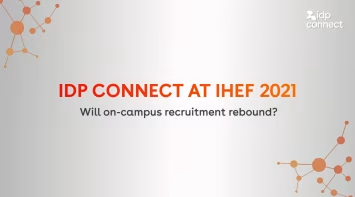These days, international education and change are synonymous. From policy 180s to market fluctuations, the last decade or so has been especially eventful for the US higher education and international education sectors. Experts have explored these trends and what they mean for the field at large. So far, one of the best frameworks we have is Rahul Choudaha’s Three Waves of International Student Mobility.
If you’re not familiar with his work, Dr. Choudaha charts out the course for international education from approximately 1999 to 2020, encapsulating major push/pull factors throughout. His framework posits that the sector has experienced three distinct cycles or waves. In Wave 1, a combination of terrorism and global policy changes evened the playing field between the US and other European countries. During Wave 2, the financial crisis of 2008 generated a change in both student profile and university targets related to international student recruitment. Finally, in this current cycle (Wave 3), we’re seeing the culminating impact of a surging Chinese higher education field and nativist movements through the Brexit referendum and the election of Donald Trump.
While this framework accurately addresses many geopolitical factors affecting international education, it has almost run its course. Now is the time to look at the current landscape and consider what the future may hold.
Before we peek into the future, let’s take stock of the current international student environment. First, let’s state the obvious: there have been major shifts in the marketplace as of late, even when accounting for the COVID-19 pandemic. Reviewing the IDP Connect Demand Tracker, the data shows that leading up to this year, global competition among the top receiving countries was getting even tighter. Changes in national policies, also outlined by Dr. Choudaha, exemplify some of the push & pull factors dictating this change. To see the other half, one has to look no further than IDP’s Student Buyer Behavior research. Here, we see an impactful combination of fears related to safety and possible visa rejections alongside affordability concerns. With the advent of the current global pandemic, the only sure outcome is change.
While our data does give us some insight into possible futures beyond this global phenomenon, we considered speaking with those who are both practitioners and leaders in their respective institutions. We asked a pair of international educators the following:
• What will be the primary focus of your admissions team in the coming years?
• What should the field of international education & individual intuitions focus on for the next 5 years?
• What should institutions do to ensure future success in both recruiting and retaining students?
• What are your hopes for the future of international education in the US?
Answers to these questions can serve as a platform for deeper discussion, both for those recruiting this year’s intake and those planning out future intakes as well.

Jessica Guiver
First, we talked to Jessica Guiver, Director of International Undergraduate Admissions with the University of Texas at San Antonio. UTSA is a public school with roughly 1,400 international students.
To start, Guiver touched on the importance of making studying abroad obtainable for more students:
I think a focus should be on making it more accessible to greater numbers of students. I started working in international education because I wanted to be a part of a field that encourages young people to step outside their “normal” and to experience the “other.”
Her comments also illustrate the opportunity that is possible for recruiters and educators: “International education is only a dream for the majority of students – some don’t even know the possibility exists – so the focus should be on making international education a reality for greater numbers.”
Moving on, Jessica remarks on where universities should focus their efforts during and throughout this pandemic:
I’d say EdTech. If the future of international travel has been fundamentally changed, so institutions should invest in providing an international education experience either virtually or by providing more experiences locally.
Besides advocating for different offerings within the curriculum, she also advises that institutions need to be “honestly and intentionally investing in internationalization,” rather than, ”paying it lip service by saying ‘we encourage all our students to study abroad and we recruit international students.’ That isn’t enough.” Her solutions range from investing in scholarships to creating international campuses but could also include investing in digital resources. The main point is that any future efforts would need dedicated action.
Lastly, Guiver ends on a positive note, detailing her hopes for international education.: “My hope […] is that it continues and grows in importance, until everyone, everywhere is touched by international education in some way.” She reflects how her own experience with international education lit her own “fire,” which still “burns brightly” even amid a global crisis.

Juho Karppinen
Juho Karppinen was once an international student himself, hailing from Finland. Now, as the Assistant Director of International Admissions at the University of Massachusetts Dartmouth, Karppinen detailed the institution’s international recruitment direction for the next few years. As a public university with around 500 international students, this pandemic will have direct impacts on the university. For UMass Dartmouth, this means a reworking of their 5-year plan, which includes a focus on markets that are currently successful. In Karppinen’s words:
“Strategies need to be reassessed periodically as changes happen. Keeping presence and building upon the work we have done in the past years is the most important thing for us right now.”
The idea of maintaining a presence in current student markets is important to Karppinen. He recommends other institutions should make this a priority for their recruitment plans:
Once the demand increases again, this will be worth the investment in the long term. Focusing on the main markets that your institution attracts students from is important, but it is also important to have a diversified strategy and focus on the emerging markets as well.
Yet, institutions need not take away focus from currently enrolled students. Karppinen suggests that supporting students now will pay dividends later as students become advocates for your institution's brand. In his opinion, this could mean “creating and promoting scholarships and on-campus job opportunities [that] help with the burden of the constantly increasing costs for international students.” Especially in this crisis, institutions that go above and beyond will reap the benefits.
Lastly, Karppinen’s ultimate hope for international education is simple. In his words:
I hope and believe that this challenging environment for the US [...] is a phase that will not last for long. I believe that the quality of a US education is still the best in the world and am optimistic that the demand for it will increase shortly.
So, What Now?
Delving through these two well-thought-out responses, there are some very clear takeaways for the future that educators need to consider:
• Be Innovative – Whether that’s investing in EdTech or other digital tools to reach students, innovation and the ability to creatively problem-solve will separate the winners and losers.
• Lower Costs – Any way universities can soften the financial blow for students is a win for the university’s brand image and loyalty.
• Have a Plan? Adjust it – The “new normal” may already seem cliché, but the impact of COVID-19 will be far-reaching. Ensure that your institution’s plan is flexible enough to operate in this new environment.
• Support Students – This is vital. If your institution drops the ball here, the ramifications could be devastating.
Additionally, having the ability to forecast possible shifts in the market is crucial. Being able to act on this insight is even better yet. Being an organization that can peer into the heart of international student recruitment in a variety of ways, we’ve ensured that we and our partners can counter any downturns in the US market. There is no better evidence than our recent merger between IDP Education and Hotcourses. Between our vast physical presence (120+ offices in over 30 countries) and our digital reach (100M visits per year), our scale allows us to test and invest in activities that have high ROI when presented with challenges in the market.
Amid the ongoing global crisis, IDP Connect is leveraging the best of both worlds. Whether it’s augmenting our specialist networks with digital capabilities or using our digital infrastructure to bring students the physical experience virtually, we’re adapting in many ways to stay the course and weather these trying times.
While we don’t know the exact future for international education, our tools can provide a head start. Utilizing our Demand Tracker (a part of our new IQ services), we’re able to see not only where student interest is but predict what future enrollments could look like for your institution.
To learn more about the Demand Tracker, click here, or contact us.info@idp-connect.com.
You might like...

Changing Parental Perceptions and Motivations in the International Education Decision Making Process
Parents are now more concerned about graduate employment opportunities than distance from friends and family.

Growing Student Markets in Africa to Watch in the Next Decade
Source market population and economic growth are key factors

How High Cost of Living and Global Economic Instabilities are Affecting International Student Perceptions
Supporting and encouraging prospective students to do financial research and their sums.



